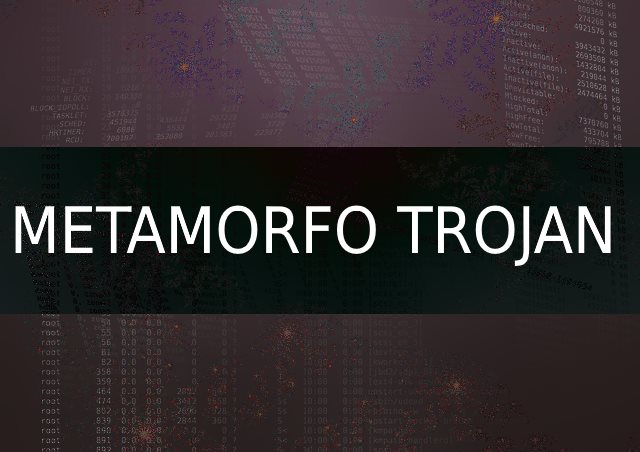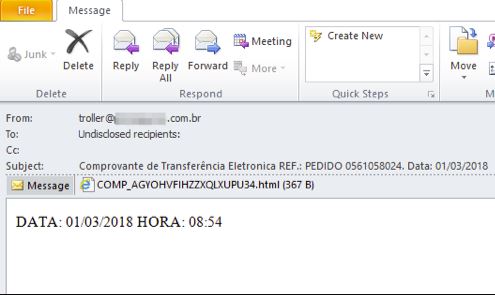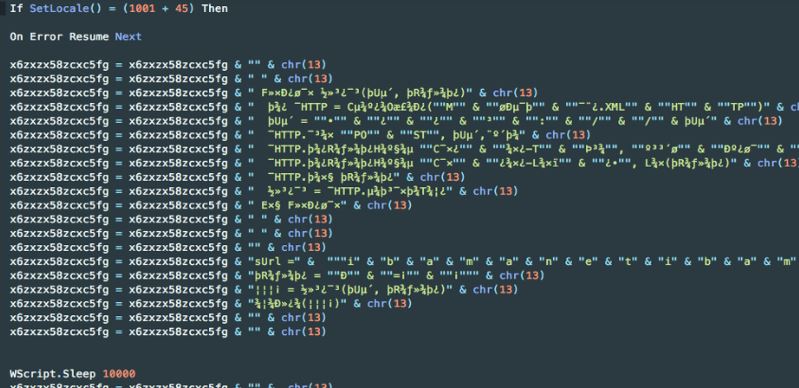 This article has been created in order to explain what is the Metamorfo Trojan and how to remove this malware completely from your computer.
This article has been created in order to explain what is the Metamorfo Trojan and how to remove this malware completely from your computer.
The Metamorfo Trojan is a newly discovered banking virus that can hijack account credentials and directly manipulate the browsers. Our removal guide features a detailed explanation of the banking Trojan’s mechanisms of operation, as well as instructions on restoring the infected computers from the infections.

Threat Summary
| Name | Metamorfo |
| Type | Trojan Horse Virus |
| Short Description | Silently infects the target machines and modifies key applications and system services. |
| Symptoms | The user may not experience any signs of infiltration. |
| Distribution Method | Malicious web links, Malicious Files, Malicious E-Mails |
| Detection Tool |
See If Your System Has Been Affected by malware
Download
Malware Removal Tool
|
User Experience | Join Our Forum to Discuss Metamorfo. |
February 2020 New Metamofo Trojan Attacks
The Metamorfo Trojan has resurfaced once again in an active campaign which is focused against users that are using online banking services. The aim of the Trojan is to harvest personal information, including credentials for banks and payment card data. So far campaigns carrying it have been launched in countries around the world, examples are The USA, Peru, Canada, Chile, Spain, Brazil, Mexico and Ecuador.
The chosen method of infection is once again phishing emails — the criminals may send out fake notifications or other types of content that the users might expect. The victims will receive informtion that they have received an invoice and manipulate the victims into downloading and running a ZIP archive. If it is run the built-in macros will execute an executable file.
One of the first modules which are run after the infection has started will be the security bypass — it will look for any running processes of security applications and engines and actively shut them down. This is done in order not to raise any alarm about the infection. The infection is done through an AutoIt script — a popular language used for automating tasks and primarily used in Microsoft Windows computers. An important operation is the disabling of auto-complete forms in web browsers. This is done in order to run a keylogger which will acquire the entered data and send them to the hacker operators behind the ransomware.
According to the available research a total of 32 keywords are monitored by the main engine for potential useful information. As soon as one of them is detected by the Trojan component it will be sent to the hackers via a secure connection.
Metamorfo – How Does It Infect

Security experts signal that a new threat known as the Metamorfo Trojan is infecting computer users in Brazil. According to the reports the primary distribution method is the use of SPAM email messages. Usually they contain social engineering elements that coerce the recipients into installing the dangerous threat. In most cases it can be either hyperlinked in the body contents or attached directly to the messages. They are also the most common carriers for viral payloads, two of the most popular types are the following:
- Infected Software Installers — The dangerous code is embedded in applications that are used by many users. Examples include office and productivity applications, creativity suites, system utilities and others.
- Infected Documents — Using the same strategy the hackers can integrate the code in documents of different types: rich text documents, spreadsheets or presentations. The code is activated through interaction with the built-in macros (scripts). When the files are opened a notification prompt appears that asks the targets to enable the scripts. If this is done the infection would follow.
The analysis shows that the hackers have devised a non-traditional scenario by crafting a malicious HTML attachment. It is designed to look like an electronic funds transfer notification. When the victim users interact with the scripts they will be redirected to a payload that may be hosted on various hosting sites or cloud service platforms: GitHub, Onedrive, Dropbox, MEGA, Google Drive and others. The security analyis shows that a shortener service is used in order to hide the redirecet URL. The payload itself is contained in a ZIP archive file and contains a single executable file. When it is started the Metamorfo Trojan infection follows.
Metamorfo – More Information and Analysis

The Metamorfo Trojan itself is composed of four elements:
- car.dat — A randomly generated name given to Windows tool.
- i4.dt — A VBS script that downloads the same zip file.
- id — An ID that is generated for each individual host.
- cryptui.dll — The malicious Trojan itself.
The Metamorfo Trojan infection process follows a multi-stage infection pattern. The first module that is launched by the main malicious engine is the data harvesting component. It can be configured to hijack two main types of information:
- Sensitive Data — It can be used to directly expose the victim’s identity by gathering strings that are related to them. Example strings include the victim’s name, address, telephone number, interests, location, account credentials or passwords.
- Campaign Metrics — The harvested information is used to optimize the attack campaigns. Example hijacked strings include hardware components information and certain operating system set values.
Further updates to it can lead to the use of a stealth protection module. It can be used to protect the virus instance from any applications that can interfere with the virus’s execution. Examples include anti-virus programs, sandbox environments and virtual machine hosts. This module is also responsible for supressing any system monitoring application and services including the following:
- Msconfig.exe (System Configuration Utility)
- TASKMGR.exe (Task Manager)
- Regedit.exe (Windows Registry Editor)
- CCleaner64.exe (CCleaner Application Instance)
- Itauaplicativo.exe
The threat is configured in a stealth manner, attempting to mask itself. It is configured to leave small file prints which is a common sign of regular system services. When Metamorfo Trojan has been deployed properly to the system and its virus engine started it will commence with the built-in instructions. The Trojan will start to hook up to the operating system and the user-installed software looking for any signs of Internet banking services or exchange platforms. This means that the developers behind the threat have devised code that is made compatible with the most popular browsers: Mozilla Firefox, Google Chrome, Internet Explorer, Safari, Opera and Microsoft Edge. Having access to them allows the criminal operators to read and write stored data such as the following: cookies, history, bookmarks, settings and stored account credentials.
The virus is then set up as a persistent threat which means that it will automatically start every time the computer boots. The Trojan can remove the possibility to enter into the boot recovery menu to disallow users from attempting to manually remove it. To make things worse the engine can also delete Shadow Volume Copies of data that is deemed important to the victims. This means that the only way it can be restored is to use a quality data recovery tool, refer to our instructions for further guidance.
The malicious engine can make various changes to the Windows Registry. When they affect any user-installed applications the users may be unable to launch certain functions and services. If the operating system is impacted overall system performance can suffer.
A surveillance module is activated which starts to record the victim users’s actions and records screenshots in the JPEG format which are saved to a predefined location.
One of the most important functions of the Metamorfo Trojan is the network connection. It is used to connect to a predefined hacker-controlled server. There have been several versions that feature different addresses, so far the following have been identified:
80[.]211.140[.]235
87[.]98.146[.]34
212[.]237.46[.]6
185[.]43.209[.]182
The analysts were able to collect some of the commands that are being used by the hacker operators:
- OK — Retrieves a list of the installed banking software.
- PING — It is being sent from the command and control servers to keep the connection alive. A PONG response is expected.
- dellLemb — Deletes the predefined registry entries.
- EXECPROGRAM — Executes a target program on the compromised host.
- EXITEWINDOWS — Exits the current operation.
- NOVOLEMBRETE — Creates a predefined registry entry that stores preset data.
As the analysis has looked over the collected samples the experts discovered that there are certain advanced stealth features built into the later strains. In them the Metamorfo Trojan includes a legitimate product made by Microsoft along with corrupted DLL files that are loaded into the system memory. It is used to hijack critical services, using the granted access an expanded data harvesting operation can be initiated.
The Metamorfo Trojan can scan the compromised computer for any banking software. It is then compared with a downloaded list from the hacker-controlled servers. Whenever an compatible application or a browser event is detected the Trojan can automatically hijack the entered credentials.
Impacted services by the Metamorfo Trojan are both online banking solutions and (crypto)currency exchanges. In addition to stealing the account credentials some versions of the malware can be customized to modify any transactions forms and replace the recipients address without the user noticing. This means that as a result of their action funds will be automatically hijacked.
At the moment there are several signatures that are being used to label the threat. The following identifiers are associated with the collected samples:
- Generic.Banker.Delf.FBD4F540
- PWS-FCJW!C2CC04BE25F2
- Script.Exploit.Generic.Wuqr
- Spyware ( 005259ba1 )
- TR/Spy.Banker.rxdds
- TROJ_GEN.R011C0OC318
- Trojan-Spy.Metamorfo
- TrojanSpy.Banker!rIQxBOu7TYM
- Virus.Banker.Delf!c
- W32/PWS.VKJI-4874

Remove Metamorfo Effectively from Windows
In order to fully get rid of this Trojan, we advise you to follow the removal instructions underneath this article. They are made so that they help you to isolate and then delete the Metamorfo Trojan either manually or automatically. If manual removal represents difficulty for you, experts always advise to perform the removal automatically by running an anti-malware scan via specific software on your PC. Such anti-malware program aims to make sure that the Metamorfo is fully gone and your Windows OS stays safe against any future malware infections.
Preparation before removing Metamorfo.
Before starting the actual removal process, we recommend that you do the following preparation steps.
- Make sure you have these instructions always open and in front of your eyes.
- Do a backup of all of your files, even if they could be damaged. You should back up your data with a cloud backup solution and insure your files against any type of loss, even from the most severe threats.
- Be patient as this could take a while.
- Scan for Malware
- Fix Registries
- Remove Virus Files
Step 1: Scan for Metamorfo with SpyHunter Anti-Malware Tool



Step 2: Clean any registries, created by Metamorfo on your computer.
The usually targeted registries of Windows machines are the following:
- HKEY_LOCAL_MACHINE\Software\Microsoft\Windows\CurrentVersion\Run
- HKEY_CURRENT_USER\Software\Microsoft\Windows\CurrentVersion\Run
- HKEY_LOCAL_MACHINE\Software\Microsoft\Windows\CurrentVersion\RunOnce
- HKEY_CURRENT_USER\Software\Microsoft\Windows\CurrentVersion\RunOnce
You can access them by opening the Windows registry editor and deleting any values, created by Metamorfo there. This can happen by following the steps underneath:


 Tip: To find a virus-created value, you can right-click on it and click "Modify" to see which file it is set to run. If this is the virus file location, remove the value.
Tip: To find a virus-created value, you can right-click on it and click "Modify" to see which file it is set to run. If this is the virus file location, remove the value.Step 3: Find virus files created by Metamorfo on your PC.
1.For Windows 8, 8.1 and 10.
For Newer Windows Operating Systems
1: On your keyboard press + R and write explorer.exe in the Run text box and then click on the Ok button.

2: Click on your PC from the quick access bar. This is usually an icon with a monitor and its name is either “My Computer”, “My PC” or “This PC” or whatever you have named it.

3: Navigate to the search box in the top-right of your PC's screen and type “fileextension:” and after which type the file extension. If you are looking for malicious executables, an example may be "fileextension:exe". After doing that, leave a space and type the file name you believe the malware has created. Here is how it may appear if your file has been found:

N.B. We recommend to wait for the green loading bar in the navigation box to fill up in case the PC is looking for the file and hasn't found it yet.
2.For Windows XP, Vista, and 7.
For Older Windows Operating Systems
In older Windows OS's the conventional approach should be the effective one:
1: Click on the Start Menu icon (usually on your bottom-left) and then choose the Search preference.

2: After the search window appears, choose More Advanced Options from the search assistant box. Another way is by clicking on All Files and Folders.

3: After that type the name of the file you are looking for and click on the Search button. This might take some time after which results will appear. If you have found the malicious file, you may copy or open its location by right-clicking on it.
Now you should be able to discover any file on Windows as long as it is on your hard drive and is not concealed via special software.
Metamorfo FAQ
What Does Metamorfo Trojan Do?
The Metamorfo Trojan is a malicious computer program designed to disrupt, damage, or gain unauthorized access to a computer system. It can be used to steal sensitive data, gain control over a system, or launch other malicious activities.
Can Trojans Steal Passwords?
Yes, Trojans, like Metamorfo, can steal passwords. These malicious programs are designed to gain access to a user's computer, spy on victims and steal sensitive information such as banking details and passwords.
Can Metamorfo Trojan Hide Itself?
Yes, it can. A Trojan can use various techniques to mask itself, including rootkits, encryption, and obfuscation, to hide from security scanners and evade detection.
Can a Trojan be Removed by Factory Reset?
Yes, a Trojan can be removed by factory resetting your device. This is because it will restore the device to its original state, eliminating any malicious software that may have been installed. Bear in mind that there are more sophisticated Trojans that leave backdoors and reinfect even after a factory reset.
Can Metamorfo Trojan Infect WiFi?
Yes, it is possible for a Trojan to infect WiFi networks. When a user connects to the infected network, the Trojan can spread to other connected devices and can access sensitive information on the network.
Can Trojans Be Deleted?
Yes, Trojans can be deleted. This is typically done by running a powerful anti-virus or anti-malware program that is designed to detect and remove malicious files. In some cases, manual deletion of the Trojan may also be necessary.
Can Trojans Steal Files?
Yes, Trojans can steal files if they are installed on a computer. This is done by allowing the malware author or user to gain access to the computer and then steal the files stored on it.
Which Anti-Malware Can Remove Trojans?
Anti-malware programs such as SpyHunter are capable of scanning for and removing Trojans from your computer. It is important to keep your anti-malware up to date and regularly scan your system for any malicious software.
Can Trojans Infect USB?
Yes, Trojans can infect USB devices. USB Trojans typically spread through malicious files downloaded from the internet or shared via email, allowing the hacker to gain access to a user's confidential data.
About the Metamorfo Research
The content we publish on SensorsTechForum.com, this Metamorfo how-to removal guide included, is the outcome of extensive research, hard work and our team’s devotion to help you remove the specific trojan problem.
How did we conduct the research on Metamorfo?
Please note that our research is based on an independent investigation. We are in contact with independent security researchers, thanks to which we receive daily updates on the latest malware definitions, including the various types of trojans (backdoor, downloader, infostealer, ransom, etc.)
Furthermore, the research behind the Metamorfo threat is backed with VirusTotal.
To better understand the threat posed by trojans, please refer to the following articles which provide knowledgeable details.


